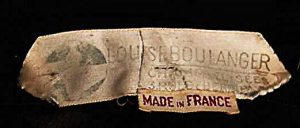French fashion designer Louise Boulanger (1878-1950) founded her eponymous fashion house, Louiseboulanger, on the Rue de Berri in Paris in 1923. She contracted her name to distinguish herself from another designer at the time.
In the late 1920s, Boulanger created dresses with hems that bridged the 1920s and 1930s: shorter in the front and longer at the back. Boulanger was in the vanguard of those creating the elegant, elongated look of the 1930s. She earned the reputation as one of the leading fashion designers of her time.
Boulanger’s personal life was deeply rooted in the artistic community, and she counted many famous painters and sculptors among her friends. This influence is evident in her designs, which often featured innovative textiles, abstract patterns, and trompe l’oeil effects. After a brief closure in 1933, during which Louise Boulanger worked for Callot Sœurs, she continued under her own name again until World War II broke out; Boulanger then closed her house.
Written by denisebrain
